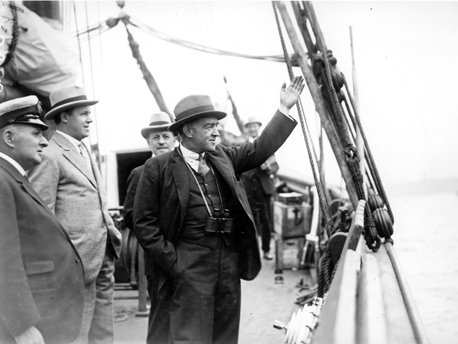Tracing Shackleton’s treacherous steps

“MEN WANTED FOR HAZARDOUS journey. Small wages. Bitter cold. Long months of complete darkness. Constant danger. Safe return doubtful. Honour and recognition in case of success.”
The recruitment ad for Ernest Shackleton’s expedition aimed at making the first ever crossing of Antarctica made the risks clear. While Shackleton didn’t succeed in his mission, the team’s adventure lived up to those promises and more, playing out as one of the greatest stories ever recorded of human grit, endeavour and survival.
In January 2013, a team hopes to replicate two key parts of that 1914 journey, using only the craft, equipment and clothing available to Shackleton and his men.
Expedition leader Tim Jarvis, AM, is a leading explorer and environmental scientist who has previously re-enacted Sir Douglas Mawson’s 1912 trek across Antarctica, using original equipment. During that journey, he spent long days and nights starving, freezing and alone. “But this will be the most challenging trip for me,” Tim says.
Paul Larsen, a sailor best known for breaking world speed records, is also well aware of the dangers of following in Shackleton’s footsteps. “This is a daunting undertaking, not to be taken on too lightly,” he says.
Ernest Shackleton heads for Antarctica, 1914
In December 1914, Shackleton set sail with a crew of 27 men. Unusually harsh conditions left his wooden ship, the Endurance, trapped in the pack ice of the Weddell Sea, where it drifted for 10 months, before eventually being crushed. Shackleton and his men camped for five months on ice floes, then, as the melting ice finally released them into the Southern Ocean, they sailed three small lifeboats that they had saved from the wreck to the bleak and uninhabited Elephant Island.

Ernest Shackleton waves goodbye as he embarks on a second expedition to Antarctic, in September 1921. (Photo: Getty Images)
In a desperate bid to find help, Shackleton and five of his men set out in one of these 6.9m lifeboats, called the James Caird. They managed to sail 800 miles through gales and treacherous seas to the island of South Georgia, which they knew was home to a whaling station. The only problem was, it was located on the other side of the island – across 26 miles of mountains and glaciers. Frostbitten and starving, Shackleton and two men achieved the impossible, completing the journey.
In August 1916, Shackleton finally got back to Elephant Island to rescue the others. Incredibly, every single member of his crew survived.
Re-enactment of historic journey
Tim plans to lead a re-enactment of the voyage from Elephant Island to South Georgia in a near-exact replica of the James Caird – named the Alexandra Shackleton after the adventurer’s granddaughter – and then to cross the rugged peaks of South Georgia.
A support ship, the TS Pelican, similar in size to Shackleton’s Endurance, will provide assistance if the team gets into serious trouble. The team’s credentials are impressive. Alongside Tim and Paul will be skipper Nick Bub, a round-the-world yacht racer; Barry Gray, the Royal Marine’s mountain leader chief instructor and Bosun Petty Officer Seb Coulthard of the Royal Navy, who has worked in some of the most inhospitable regions of the world.
However, the team will use only the equipment and methods that were available to Shackleton, including celestial navigation and a sextant. They will also sport 1914-era clothing.
As Paul points out, Shackleton’s journey didn’t pan out as he’d expected, and he found himself in situations he would never actually have chosen to put himself.
“The boat isn’t very well suited for the sea journey,” adds Tim. “It could easily capsize. Landing at South Georgia will also be extremely rough.” In fact, it’s one of the most daunting shores in the world, says Paul. And they could face even tougher challenges than those encountered by Shackleton.
“The crevassing on South Georgia will be worse for us,” says Tim. “With climate change, a lot of the crevasses that would have been filled with snow back in Shackleton’s day are no longer.”

Tim Jarvis (left) and Barry Gray load up the replica boat with supplies ahead of their historic adventure. (Photo: Tim Jarvis)
Spotlight on environmental issues in Antarctica
Tim and his team hope that the expedition will highlight some of the environmental problems facing Antarctica. Conservation charity Flora and Flora International will receive funds raised from the expedition.
Dr Esther Bertram, senior programme manager for conservation science at Flora and Fauna International, and an expert on Antarctica, is looking forward the team’s work. “They will be able to record changes in the glacial cover of South Georgia Island, see empty valleys that would previously have been covered in ice in Shackleton’s time – all potentially indicating the impacts of a changing climate,” she says.
Tim hopes the expedition will also be useful in other ways. “Shackleton’s principal message was about getting a very disparate group of men to pull together to achieve their goal against very, very significant odds – and I think that message is a very relevant one for the world today.
“Whether it’s climate change or the global financial crisis, I think we need collective rather than individual action,” Tim says.
Tim farewelled Australia on Sunday. The expedition is scheduled to start in early January, 2013.
RELATED STORIES




